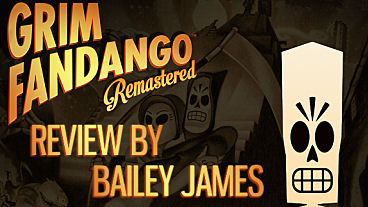
Grim Fandango Remastered Review
I am grateful that funny, stylish, thoughtful games still have an audience in an era that’s growing increasingly obsessed with cutting-edge graphics and streamlined gameplay rather than stories.







Genre: Point-and-Click Adventure
It’s often said in the gaming community that Grim Fandango is the best adventure game ever made. Few can dispute that it’s a crown jewel of the genre with a story, characters, and ambiance that can’t be missed. So when I heard that the game was being remastered by Double Fine Productions, I took it as incredible news. An update of an old favorite can have disastrous results, like hearing a bad cover of your favorite song at karaoke night, but I had an almost foolish amount of faith that Grim was above such concerns. It was so untouchable, so pure of essence that it couldn’t be tainted.
Thankfully, I was right. The remaster does everything right, preserving what made the original so memorable while polishing up a few worn spots and porting the game to new platforms so that it can get the wider audience it deserves. Nothing on Earth or the Eighth Underworld is perfect, but Grim Fandango Remastered comes pretty damn close.
The Story and Characters
You’re Manny Calavera, a skeletal (but in no way frightening) grim reaper paying his dues in the Land of the Dead so he can journey onward to the next world. How? By acting as a travel agent, securing his newly-departed clients travel packages commensurate with their relative goodness on Earth. The pure of heart are given tickets on the Number Nine express, a luxurious train that takes its passengers to their destination in just four minutes, while the less-than-holy must resort to slower means.
Manny’s clock-punching existence (even reaping souls can get dull if you do it long enough) is shaken up by the arrival Meche Colomar, a saintly woman who could bring a commission big enough to rescue Manny from desk duty—except she disappears after being told she’ll have to make the four year trek through the Eighth Underworld on foot. But when Manny discovers evidence of shady dealings, he sets out after her to restore order and save his own—well, not skin, but you get the idea.
Grim Fandango draws much of its tonal inspiration from film noir, with Manny cast as the suave gumshoe. But he doesn’t fall prey to tired tropes. He’s also funny and odd and motivated by more than an unflagging quest for justice; he takes time along the way to build a career and to make friends. He succeeds, in short, in feeling real. One of the most singular delights is in watching his motivations shift and deepen, which is made possible by the game’s ingenious four-act structure. By giving him time to settle into each of the places he calls home, the relationships he develops with the other characters are rich and diverse rather than perfunctory. He flirts, he banters, he pleads, he apologizes, and we don’t need to have everything explained to us to understand that he’s an inextricable part of the microcosm he occupies.
All the characters, in fact, whether they travel alongside Manny for years or make brief, singular appearances, feel defined as well as delightful. The voice acting is impeccable and the jokes are fast and zany. The dialogue is abundant and often optional, but you’ll be missing out if you don’t follow every conversational thread to its conclusion.
Ultimately, the writing is fresh and inventive and manages to explore weighty issues — reincarnation, the afterlife, the implications of our actions once we’re gone — in a way that’s genuinely thought-provoking without being pedantic. It’s the reason a niche game from the ’90s got remastered in the first place, and any gamer who doesn’t experience it has a serious gap in his or her experience.
Atmosphere
Part of what makes this absurd story so immersive is the inimitable world in which it takes place. The mash-up of Aztec culture, art deco architecture, Day of the Dead imagery and vintage detective movie trappings is so random you can’t help but take the leap of faith, and once you’re in, you buy it fully. It’s just so joyous to behold.
The best part is arguably the flashy mob town of Rubacava, where the shady noir touches are oozing out of every backdrop from gambling clubs to moonlit docks, but even the most mundane objects have a stylized design that reflects a confluence of cultures. Each area has its own distinctive architecture and inspirations that create the sensation that this world is much larger than what we see onscreen; it exceeds its own boundaries.
The characters themselves have a blocky appearance that I was surprised to see mostly unchanged in the remaster. The surfaces have been smoothed out and re-textured, but some of the models (the giant demon Glottis in particular) still appear planar and rough. But then again, a more convincing or realistic skeleton would do the game no favors; though the stakes are high and mortal souls are on the line, the afterlife isn’t meant to be a scary place.
But nothing sets the tone quite as effectively as the music. Re-scored with a full live orchestra for the remaster, the soundtrack bristles with emotion and color. It’s jazzy and evocative but always understated. When Manny is up on a high building ledge the music grows airy and dizzy, evoking vertigo; but scenes set in casinos feel jangly and frenetic. The sound design is thorough — when Manny runs across a metal grate set into a concrete street, you can hear the difference between the two textures in his footfalls. You’ll feel the soundtrack at work, but it’s done its job well enough that you often won’t notice.
Gameplay
The most significant overhaul (after making the game compatible with modern computers, at least) is in redesigning the control scheme. A tank-based key system that failed to integrate the computer’s mouse made the old version unwieldy, and environments were hard to explore for inventory items and puzzles. Now there’s a mouse and trigger system that activates over relevant objects and characters, giving Manny the option to perform basic commands like picking up an item or talking to a person without having to remember particular key commands. This is a vast improvement. Remnants of the old schema remain—when Manny is near a point of interest, such as an object on a desk, his head will automatically turn to look at it. But you’ll be relieved not to have to bump up against every available surface while pressing the “use” key to make sure you’ve found everything.
Fans of the original often complained about the inventory system, which was clever but clumsy to use. Manny would tuck objects into his jacket and you’d have to watch him pull each one out in turn to find what you wanted to use. This was an annoying conceit during a couple of time-sensitive sequences, but overall I didn’t find it a nuisance. If you hated this before you’ll still hate it now, but for me it rarely presents a problem.
One new element that has appeal for veteran fans is the optional director’s commentary, recorded by the creators on the occasion of the remaster. My advice: skip it. Though I was at first intrigued by the influences and work habits of the game-makers, many of the anecdotal snippets are long, jargon-filled meditations on the technical processes that run the game. Interesting to someone interested in computer programming themselves, perhaps, but not for me. If you insist on giving them a try, I recommend turning on the commentary only at the beginning to get a quick primer on the inspirations, then disabling it once you leave El Marrow so you can fully immerse yourself in the story without intrusions. See too much of the scaffolding that holds up this world and it’ll start to seem a little less magical.
The Puzzles
The puzzles are, admittedly, the element of Grim Fandango that’s quickest to betray the game’s age. They’re very much a product of the obtuse “adventure game logic” trend that plagued the ’90s, and chances are if you’re not either familiar with the genre, prepared to try shoving every inventory item in every possible location, or completely devoid of regular human reasoning, you’ll get stuck. Who would think, after all, to use liquor with gold flakes to set off a metal detector? Or to use a desk toy as a grappling hook? If you’re like me and get impatient when the story slows down just because you can’t figure out how to dispatch a flaming bone beaver, you’ll have a better time if you’ve got a walkthrough open.
None of this is to say that I think the puzzles should have been changed. They’re endemic to the whole-hog silliness of this universe. Manny wouldn’t be quite as charming if his problem-solving approach weren’t utterly ludicrous. The puzzles are funny once you know the trick, and you’ll feel uncommonly smart if you manage to crack a hairy one.
Conclusion
Grim Fandango has plenty of flaws, but if you don’t enjoy playing it, chances are it’s because you want it to be something it’s not. Even after an update the game still feels dated and challenging in places, but as an act of storytelling it’s unprecedented. It succeeds in what so few games achieve: it shows growth and change. The Manny Calavera we first meet pushing paper in a cheap polyester suit isn’t the same man who unearths the conviction to make the Underworld a better place for the people he comes to love. He discovers purpose in death as he never did in life.
I am grateful that funny, stylish, thoughtful games still have an audience in an era that’s growing increasingly obsessed with cutting-edge graphics and streamlined gameplay rather than stories. Titles like Grim Fandango, especially as they find new audiences, make it possible for others to push the envelope and demand more of players, and to give them more in return. When LucasArts first put out a meandering noir adventure about the entanglement of mortality and meaning, they couldn’t have known that it would become a cornerstone of the genre. But if you’ve played it and loved it, the game stays with you long after you think you’ve put it down. It is a companion on our own grim dances through life—those endless, pointless journeys shot through with joy.
|
+ Unique and engaging story
+ Unforgettable, dynamic characters
+ Humorous script
+ Immersive atmosphere and score
+ Talented voice acting performances
+ Worth the money ($14.99 for 12-15 hours of gameplay? You bet!) – Obtuse, illogical puzzles – Clunky inventory system
– Lackluster director’s commentary |

|
MINIMUM PC:
OS: Windows Vista or Later
Processor: Intel® Core™ 2 Duo 2.4 GHz, AMD Athlon™ X2 2.8 GHz, or higher
Memory: 4 GB RAM
Graphics: ATI Radeon HD 4650 / NVIDIA GeForce GT 220 / Intel HD 4000 Graphics, or equivalent
Hard Drive: 6000 MB available space
Sound Card: Windows Compatible Card
Additional Notes: GPU that supports OpenGL 3.3 or higher
MINIMUM MAC:
OS: OS X Mavericks (10.9.x) or later
Processor: Intel® Core™ 2 Duo 2.4 GHz, AMD Athlon™ X2 2.8 GHz, or higher
Memory: 4 GB RAM
Graphics: ATI Radeon HD 4650 / NVIDIA GeForce GT 220 / Intel HD 4000 Graphics, or equivalent
Hard Drive: 6000 MB available space
Additional Notes: GPU that supports OpenGL 3.3 or higher

Leave a Reply